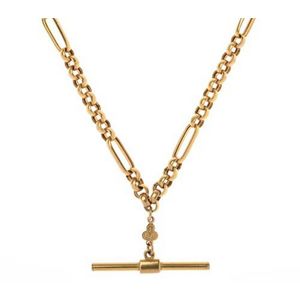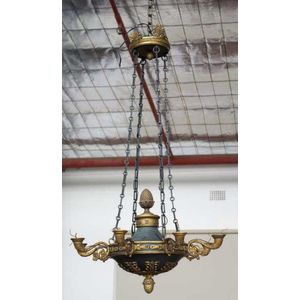Empire Bronze Chandelier with Pineapple Finials and 8 Branches
Good Empire bronze and ormolu chandelier light with central pineapple finials and 8 scrolling branches, suspended by bronze chains, wired to electricity, 65 cm diameter, 66 cm long
You must be a subscriber, and be logged in to view price and dealer details.
Subscribe Now to view actual auction price for this item
When you subscribe, you have the option of setting the currency in which to display prices to $Au, $US, $NZ or Stg.
This item has been sold, and the description, image and price are for reference purposes only.
- Finial - An architectural decoration, found on the upper parts of of an object. On furniture they are usually found on pediments, canopies and shelf supports. On smaller ceramic or silver items, such as spoons, they may decorate the top of the item itself, or the lid or cover where they provide a useful handle for removal.
Finials have a variety of shapes and forms. They may be urn-shaped, baluster shaped round or spiral, but usually taper into an upper point. Many real life shapes may also be used as finials, such as pineapples, berries, pinecones, buds, lotus and acorns. Sometimes animals such as a lion are depicted, or fish and dolphins. - Bronze - An alloy of copper and tin, traditionally in the proportions of about 9 parts of copper to 1 part of tin.
The discovery of bronze in Western Asia in the 4th century enabled people to create metal objects which were superior to those previoulsy possible because of its strength and hardness, and it has been used throughout the world for weapons, coins, tools, statuary and other decorative items.
It is very fluid in a molten state, and its hardness, strength when set, and non-corrosive properties makes it most suitable for casting sculpture. - Ormolu - Ormolu was popular with French craftsmen in the 18th and 19th century for ornamental fittings for furniture, clocks and other decorative items. True ormolu is gilt bronze, that is bronze that has been coated with gold using a mercury amalgam. Due to the health risks associated with using mercury, this method of creating ormolu was discontinued in France in the 1830s. A substitute was developed consisting of about 75% copper and 25% zinc, however it was inferior to the bronze version. It was often lacquered to prevent it tarnishing.
- Pineapple - The pineapple, named because of its resemblance to a pine cone, was an exotic and scarce fruit in the 18th century. It became a popular decorative motif on furniture, silver ceramics, glass and clocks during this time.
This item has been included into following indexes:
Visually similar items

A large and impressive gilt wood ceiling lantern, Italian 18th/19th century, 100 cm high
Sold by
in
for
You can display prices in $Au, $US, $NZ or Stg.

A 9ct gold Albert style chain, belcher and fetter links with t-bar and swivel clasp, length 45.5 cm, wt 12.2g.
Sold by
in
for
You can display prices in $Au, $US, $NZ or Stg.

Vintage French style wall mirror
Sold by
in
for
You can display prices in $Au, $US, $NZ or Stg.

A bronze and glass hexagonal hallway lantern, French, 19th century, 68 cm high, 36 cm wide
Sold by
in
for
You can display prices in $Au, $US, $NZ or Stg.
